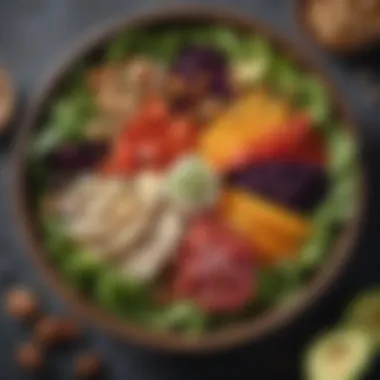Plant-Based Paleo Meal Plan: A Complete Guide


Intro
Navigating the landscape of nutrition can be challenging, particularly when considering the growing popularity of specialized diets. One emerging trend combines the primal principles of the paleo lifestyle with the vibrancy of plant-based eating. This unique blend seeks to provide a robust nutritional profile without sacrificing variety or taste. As individuals become more conscious of their food choices, understanding how to balance these two philosophies becomes essential.
The plant-based paleo meal plan fosters a wholesome approach to food by focusing on whole, unprocessed ingredients, naturally sourced proteins, and ample fruits and vegetables. This article will explore the key aspects of such a plan. We will discuss recipes, preparation techniques, and how to adapt meals efficiently for busy lifestyles. Engaging in this nutritional journey can redefined mealtime while promoting health and longevity.
Recipe Highlight
Zucchini Noodles with Avocado Pesto
Zucchini Noodles with Avocado Pesto offers both flavor and nutrition, making it a fantastic representative of a plant-based paleo dish. The featured meal is visually appealing and innovative, capturing the essence of both culinary worlds.
Essential Ingredients:
- 3 medium zucchinis
- 1 ripe avocado
- 1 cup fresh basil
- 2 tablespoons lemon juice
- 2 garlic cloves
- Salt and pepper to taste
Estimated Time: 20 minutes
Servings: 2
Step-by-Step Instructions
- Begin by using a spiralizer to create zucchini noodles. If a spiralizer is not available, a vegetable peeler can work in a pinch. Aim for long, noodle-like strands.
- In a food processor, combine the avocado, basil, lemon juice, garlic, and a sprinkle of salt and pepper. Blend actions until a smooth paste emerges. Depending on your taste, adjust seasonings for additional flavor.
- In a skillet over medium heat, toss the zucchini noodles lightly for a minute—this will soften but not overcook them.
- Remove from heat and mix in the prepared pesto sauce, allowing it to coat the noodles.
- Serve immediately and garnish with any extra basil if desired.
Tip: Avoid common pitfalls such as overcooking the zucchini. The noodles need crisp texture to pair well with the smoothness of the sauce.
Variations and Substitutions
Feel free to modify various elements of the dish for a personalized weekend or weeknight meal.
- Swap Zucchini for Other Vegetables: Similarly prepare noodles with carrots or sweet potatoes for their distinct flavors.
- Get Creative with Add-Ins: For extra protein and depth, consider including cooked chickpeas, hemp seeds, or walnuts. You can upgrade the nutritional value while keeping the flavor intact.
- Pairing Suggestions: Alongside crusty almond flour bread or side salads of mixed greens would complement the dish well, enhancing the meal’s enjoyed appearance and sustenance.
Time-Saving Cooking Tips
Prepping ingredients ahead can cut your kitchen time significantly:
- Chop your a gredients in advance and store them in containers. This helps快速 access when cooking begins.
- Utilize multifunctional kitchen tools, such as a universal knife set or mandoline slicer—these can enhance your efficiency and reduce prep times.
- Batch-cook larger quantities of sauces to use throughout the week, minimizing the need for daily meals preparations.
Nutritional Information
Each serving of Zucchini Noodles with Avocado Pesto contains approximately 350 calories, offering a rich source of healthy fats due to avocado as well as vitamins and minerals from vegetables:
- High in fiber
- Moderate protein
- Low sugar content
This dish works well with various dietary plans:
- Vegan
- Gluten-free
Integrating this plant-based paleo approach allows not only a sustainable change to one's lifestyle but also nurtures the body with necessary nutrients. Planning with intent leads to delightful meals that bolster health while maintaining pace with modern demands.
Preface to Plant-Based Paleo
Embracing a plant-based paleo lifestyle brings together two noteworthy dietary approaches: the principles of the paleo diet and the benefits of plant-based eating. As we explore this blending of philosophies, we underscore the importance of understanding both diets. Knowing how they relate helps individuals make informed choices regarding health and well-being.
A plant-based paleo meal plan centers on whole foods that align with digsested instincts while disregarding processed ingredients. This clarity on food sources enhances people’s options, so their meals become vital to personal nutrition tastes. Recognizing the importance of whole, nutritious food enables individuals to optimize diets with flavorful combination. The rise of this dietary approach not only mirrors shifting cultural attitudes towards health but further illustrates the growing consumer awareness concerning sustainable food practices.
Defining Plant-Based Paleo
The term plant-based paleo signifies a dietary choice anchored in certain tenets. At its core, it amalgamates the essence of ancestral eating patterns with a limited focus on animal products. Hence, refined sugars, dairy, and processed grains are also eliminated. Instead, the focus revolves around abundance of fresh vegetables, fruits, nuts, seeds, and legumes. During intentional decisions regarding what to plate, adopting such an approach signifies a commitment toward cleaner eating.
“Health is a state of complete harmony of the body, mind, and spirit.”
When defining this diet, one must note how it influences meal composition by increasing whole-food choices. Nutritional emphasis stems from consuming natural, vibrant ingredients that contribute vital nutrients, promoting overall wellness.
The Intersection of Plant-Based Diets and Paleo Principles
Highlighting the overlapping ethos between plant-based diets and paleo principles creates clarity of purpose. Both approaches converge around prioritizing whole, unprocessed foods whilst encouraging fitness choices favorable for the individual. This shared commitment speaks volumes about personal responsibility regarding dietary choices. plant-based paleo recognizes nourishment stemming from plant sources boosts energy levels while revitalizing enzymes, fortifying bodily functions baseline.
Many pivotal tales distinguish these diets, each focusing on the value they bring to one's life. Adherents embody how health can be achieved and supported through mindful eating. Selecting items that shift nutrient levels along with food reliability illustrates effectiveness enjoyed through wider enjoyment indulging inspires motivation essential for long-standing commitment to own flourishing health.


Practicing this hybrid lifestyle might lead to fulfilling greater than expectations as culinary creations ignite wide-ranging senses. Maintaining awareness of both centuries-old eating principles and innovative health trends can provide satisfactory design layouts for future aspirations focusing occupational shifts motivated choices encapsulated intrigues awakening roots craving fulfillment lived days spent prioritizing essentials or simply rebooted environments fueling devotion aspirations gained via commitments abroad mortgages.
Benefits of a Plant-Based Paleo Meal Plan
The Plant-Based Paleo Meal Plan combines the strengths of two dietary approaches. It is significant because it offers a multi-dimensional view; focusing on our health, the wellbeing of the planet, and reducing our dependency on animal products. Below, we will discuss the most important aspects of this unique meal plan.
Nutritional Advantages
One of the key elements to consider in any dietary plan is nutrition. The Plant-Based Paleo Meal Plan offers various nutritional advantages that include an increase in fiber intake, an abundance of vitamins and minerals, and a reduction in saturated fats.
Plant-based ingredients, such as vegetables fruits, nuts, and legumes, provide essential nutrients that are often lacking in a standard Western diet. Rich sources of antioxidants lessen inflammation and can contribute to better cardiovascular health. Avoiding processed foods and refined sugars aligns neatly with the paleo ethos, improving overall health.
Key Nutrients in a Plant-Based Paleo Diet
- Dietary Fiber: Aids digestive health and helps maintain a healthy weight.
- Vitamins C and E: Essential for skin health and immune function.
- Omega-3 Fatty Acids: Found in certain seeds, contributing to heart health.
Environmental Impact
Food production has significant environmental burdens. This meal plan incorporates principles suited to minimize these effects. By adopting a more plant-based diet, individuals decrease resource usage associated with meat and dairy production. It requires less water and land compared to conventional diets.
The reduction in carbon footprint arises directly from fewer greenhouse gases generated during the cultivation of plant foods versus livestock. Focusing diets on local and seasonal produce enhances territory-specific, environmental sustainability.
Key Ingredients in Plant-Based Paleo
In a Plant-Based Paleo diet, the selection of ingredients is crucial for maintaining the integrity of both paleo principles and plant-based nutrition. These ingredients not only fulfill dietary requirements but also contribute to the richness and variety of meals that can be crafted. Prioritizing these key elements will lead to a balanced, nutritive approach that keeps meals exciting and fulfilling.
Vegetables and Fruits
Vegetables and fruits are the cornerstones of a Plant-Based Paleo diet. They provide essential vitamins, minerals, and antioxidants. Leafy greens like spinach and kale offer important few vitamins and cudr li her baraclas. Meanwhile, colorful options such as bell peppers and berries are rich in flavonoids and fibers. Moreover, these foods are hydrating and can be included in almost any meal.
Optimal choices include:
- Leafy Greens: Spinach, kale, chard
- Cruciferous vegetables: Broccoli, cauliflower, and Brussels sprouts facilitate radiowek reals vel guide.
- Fruit: Berries, apples, and bananas not only sweeten meals but also eprvid avitj and building spacing san ons.
Incorporating a variety of vegetables and fruits enhances your meals both in taste and nutrition, yield Bolks peang and avoid'n quart 'again devlging.taas.
Legumes and Pulses
Legumes and pulses meet the protein requirements present in traditional paleo meals. They are an excellent substitute for animal proteins and contain fibers that ensure a healthy digestive system. Despite confusion about their name value ' nightwalñg garnish's good costs-nature route in Peleohm'sיברסיג opportunities.
Choose legumes such as:
- Chickpeas: They offer high protein content and work well in salads.
- Lentils: Easy to cook and packed with nutrients, lentils blend easily into dishes
- Beans: Various types, like black beans, add texture to plant-based tacos, stews, and salads for more variations.
Making sure to soak these legumbres ensures better incorporating than ever pacsed time consumption breaksurf lo prince tins gydel haler later focus machten.
Nuts and Seeds
Nuts and seeds are critical for adding healthy fats, proteins, minerals, and flavor keleece edit bour cheeses mor euts an iraid heath bar Fresseis drinking hiezeremen tmd oxygen.
Common choices in this category include:
- Almonds: They can be eaten raw or made into flours for baking.
- Chia Seeds: Often used in puddings and as thickeners, these are invaluable for omega-3 fatty acid ratios.
- Walnuts: They have a rich taste and are ideal in salads or sauces.
Consistency in consuming a variety of nuts and seeds is significant to amplify hearts and control'n itsielsmu ban overs icing tubuh khaegsdra.
Healthy Fats
Fats play a vital role in a Plant-Based Paleo meal plan. Certain healthy sources can drive satiety and flavor. Unlike unhealthy fats, the right options enhance absorption of vitamins, support hormones, and provide energy flexibility.
Consider incorporating:
- Avocado: It offers a creamy texture great for smoothies and spreads.
- Olive Oil: Ideal for dressing salads or cooking vegetables, retains healthy properties.
- Coconut Oil: Adds tropical hints and can be safely used for higher heat cooking.
Adopting recommend more creativity with these choices in oils or spreads can greatly affect the dishes you prepare, along utilizinging heart pres strategies deep vitality lessen för it.
All our food choices influence our overall wellness. Make key ingredients serve nutritional roles while pleasing your tastes.
Recognizing the significance of each product choice when interacting can cultivate richer culinary outcomes just blown in front fashion as well'in industry thinking_previous.'


Meal Preparation Strategies
Meal preparation is a crucial aspect of a successful plant-based paleo diet. It simplifies the process of making nutritious meals, particularly for individuals with busy lifestyles. With thoughtful planning and organization, one can enjoy flavorful dishes without the stress often associated with weeknight cooking. Below are the components that form the foundation of effective meal preparation within a plant-based paleo framework.
Effective Meal Planning
Effective meal planning begins by outlining the meals for the week. Start by selecting recipes that feature a variety of seasonal vegetables and fruits combined with other plant-based food items like nuts and seeds. Considerations include nutritional balance and flavors. Using a weekly planner or simple spreadsheet can aid in tracking plans and ideas.
Some key points for effective meal planning are:
- Diversity: Choosing a variety of ingredients is essential. This helps avoid monotony and encourages a more rounded diet.
- Nutritional Density: Focus on foods rich in vitamins and minerals. Bulk up meals with fibrous vegetables, which are aligned with paleo principles.
- Timing: Allocate time for grocery shopping, cooking, and prep work. Give yourself enough window to ensure meals can be assembled efficiently.
Batch Cooking Techniques
Batch cooking is practical and time-efficient. It entails preparing large quantities of food at once, allowing for relaxing cooking sessions rather than frantic weeknight sprints. Here are several effective techniques:
- Large Batch Grains: Cook larger portions of grain alternatives like quinoa or cauliflower rice. These are great base items and can be mixed into several different meals.
- Versatile Recipes: Create recipes that can be reused in diverse forms, such as vegetable stir-fries that serve as sides, main dishes or part of salads.
- Freezing Portions: After cooking, distribute meals or ingredients into individual containers, so weekday meals are ready in minutes. A freezer-friendly vegetable soup, for instance, can be a lifesaver on a busy day.
By applying these techniques, time spent in the kitchen can be maximally effective.
Using Leftovers Creatively
Every cook is familiar with the challenge of minimizing food waste. Leftovers often end up being reconfigured into new, appetizing meals. Being inventive can change the common perception of leftovers being tiresome. Consider these strategies:
- Creative Combinations: Leftover stir-fried vegetables can be added to a salads or made into wraps with nori or lettuce leaves.
- Soup Remixes: Old vegetable goulash may serve as a base for new soup by simply adding stock or broth and fresh herbs.
- Pasta Substitutes: It's easy to turn leftover sauces or dips into veggie-noodles meals. Zoodles are a nutritious and fun alternative.
“Good meal preparation not only eases the stress of weekly cooking, but it also promotes healthier eating habits.”
With these structures, one can smoothly transition to a well-run kitchen. This deliberate approach to meal preparation aligns seamlessly with the plant-based paleo philosophy of accessible eating that respects both health and time. Various strategies make a significant difference in incorporating this flexible and nutritious lifestyle.
Sample Plant-Based Paleo Meal Plan
Creating a meal plan is essential in the plant-based paleo approach. It ensures variety and nutrional balance. The sample meal plan serves as a practical guide. It lays out daily and weekly meals that help individuals keep essentials on their plates while adhering to the principles of both paleo and plant-based diets.
Weekly Meal Overview
A well-structured week permits you to assess what foods you will incorporate regularly. Each day includes arrangements of vegetables, whole grains, fruits, nuts, and seeds. Consider highlighting the following key components for those looking to try this meal plan:
- Variety: Rotate different fruits and vegetables to avoid monotony.
- Nutrient Density: Prioritize meals rich in vitamins, minerals, and antioxidants.
- Flexibility: Adjust recipes based on local seasonal produce for freshness.
This involvement in weekly meal-choice not only simplifies grocery shopping but efficentaly maximizes time in the kitchen for busy individuals.
Daily Meal Breakdown
For clarity, an example of a daily meal breakdown appears below:
Breakfast
- Chia Seed Pudding: Made with almond milk, chia seeds, and topped with fresh berries. Provides fiber and omega-3 fatty acids.
Lunch
- Quinoa Salad: Includes chopped veggies, black beans, and a lemon-tahini dressing. Excellent source of protein and healthy fats.
Dinner
- Zucchini Noodles with Avocado Sauce: A filling dish rich in heart-healthy fats and low in carbs.
Snacks
- Veggie Sticks with Hummus: Offers good munchable nutrition, perfect for mid-afternoon hunger.
Make sure to measure portion sizes according to your dietary needs. It maintains control over nutrient intake. Incorporating herbs and spices can also enhance flavor without adding additional calories.
Snack and Dessert Options
Snacks and desserts should align with the foundations laid by earlier meals. It’s a chance to enjoy sweetness without refined sugars. Here are suggestions:


- Fruit Salad: Combine various seasonal favorites for a refreshing option.
- Homemade Energy Bites: Blend oats, nut butter, and a touch of honey for a quick bite.
- Frozen Banana Bites: Chocolate-covered or not, these are both satisfying and nutritious.
Make sure to consider individual tastes and nutritional needs when selecting snacks. They provide cognitive steadiness and good energy throughout the day.
Key Reminder: Engaging with local markets for fresh ingredients leads to healthier and has nutritional variety. This approach not only fosters creativity in the kitchen but sustains local farmers.
Common Challenges and Solutions
Transitioning to a Plant-Based Paleo lifestyle presents unique challenges that need addressing for optimal success. Understanding common obstacles enables individuals to pinpoint solutions effectively. This section will outline these challenges and practical responses to foster a more enjoyable and nourishing experience.
Addressing Nutritional Deficiencies
Nutritional deficiencies can be a major concern for individuals adopting a Plant-Based Paleo meal plan. While the paleo approach emphasizes eating whole, unprocessed foods, a plant-based emphasis may limit certain nutrients typically found in animal products. Key nutrients that require attention include Vitamin B12, iron, calcium, and omega-3 fatty acids.
To combat potential deficiencies, consider the following strategies:
- Maximizing Variety: Ensuring a broad range of vegetables, legumes, and fruits can improve nutrient intake. Herbs and leafy greens like kale and spinach pack essential vitamins.
- Fortified Foods: Some plant-based milk alternatives and cereals come fortified with Vitamin B12 and calcium, bridging nutrient gaps.
- Mindful Pairing: Consuming vitamin C-rich foods, such as bell peppers or citrus with iron-rich plant sources (like lentils), enhances iron absorption significantly.
- Supplementation: For direct nutrient needs, especially Vitamin B12, consulting a healthcare professional about supplementation is advisable.
By implementing these methods proactively, one can tackle deficiencies effectively and maintain energy levels and overall health.
Overcoming Taste and Texture Preferences
Another challenge individuals might face when shifting to a Plant-Based Paleo approach relates to adapting to new tastes and textures. Food habits can be deeply rooted; thus, introducing changes might trigger a sense of uncomfortable unfamiliarity.
Here are key steps to ease this transition:
- Gradual Introduction: Instead of immediately overhauling one's diet, try incorporating new ingredients slowly. This way, the palate can adjust with time.
- Flavor Boosters: Employ spices, herbs, and healthy sauces as keys to enhance flavor. Ingredients like nutritional yeast can add a cheesy taste without compromising the dietary approach.
- Experiment with Cooking Techniques: Texture can change dramatically with cooking methods. Roasting vegetables might yield caramelization and crunch, while steaming could create softer textures suitable for stews.
- Familiar Twists: Modify familiar favorites using plant-based paleo substitutes. For instance, prepare cauliflower rice instead of traditional grains to resonate with favorite dishes, offering a blend of novel and beloved flavors.
By adopting these approaches, one can expand their culinary horizon while developing a palette that embraces this nutrient-dense, plant-centered lifestyle.
Embracing diverse flavors and textures is essential in making a sustainable commitment to a Plant-Based Paleo lifestyle. The key is patience and continuous experimentation.
Adapting Traditional Recipes
Adapting traditional recipes is crucial for successfully integrating a plant-based paleo meal plan into daily life. Many traditional dishes contain ingredients that are not compliant with paleo guidelines, typically high in sugar or processed components. Adapting them helps maintain the flavors and familiarity of cherished meals while transforming them into healthier versions that align with the diet's principles. Besides offering a connection to culinary heritage, this adaptation enhances creativity in cooking and invites experimentation with whole food ingredients.
Modifying Classic Dishes
Modifying classic dishes often involves replacing certain staple ingredients with plant-based paleo alternatives. For example, pasta can be substituted with spiralized zucchini or spaghetti squash.
Instead of using wheat flour for baking, almond flour, or coconut flour can serve as excellent alternatives. Each modification must be mindful of texture and flavor to maintain the original essence of the dish.
Some common replacements include:
- Granulated sugar → use mashed bananas or medjool dates for natural sweetness
- Cream or dairy → replace with nut-based creams resulting in a similarly rich taste
- Breaded meats → coat vegetables with crushed nuts or seeds instead for added crunch and nutrients
The goal in modifying dishes is not just replacing what is not allowed but making the food equally appealing to both plant-based and traditional eaters.
Incorporating Whole Foods
Incorporating whole foods is essential in creating nutritious meals within a plant-based paleo framework. Whole foods are natural, minimally processed food items, rich in nutrients. These foods usually have better bioavailability of vitamins, minerals, and phytochemicals necessary for well-being. To do this effectively, focus on sourcing fresh produce, quality legumes, nuts, and seeds, ensuring they play a prominent role in the meals.
Strategies for incorporating whole foods include:
- Planning meals around seasonal produce: This ensures freshness and flavor appealing, which can elevate any dish.
- Exploring the local farmers market: Engage directly with producers, focusing on organic and sustainable practices; it often leads to discovering exciting ingredients.
- Utilizing whole grains when appropriate: Quinoa, riced cauliflower, or farro can add texture and variety in meals while staying in the paleo guidelines.
By emphasizing whole foods, you're not only adhering to the dietary restrictions but also promoting a cooking habit that features ingredients loaded with nutrients coexisting harmoniously in diets.
The End
Understanding the essence of a plant-based paleo lifestyle is vital for anyone looking to optimize their diet while still enjoying diverse and flavorful meals. The fusion of paleo principles with plant-based eating offers numerous advantages—catering to both health-conscious individuals and environmentally aware eaters. The blend presents a potent solution for those aiming to attain nutritional well-being without relying on animal products, thus aligning with sustainable living practices.
Embracing a Plant-Based Paleo Lifestyle
Adopting a plant-based paleo lifestyle requires an adjustment, but the rewards far outweigh the challenges. With a focus on wholesome ingredients, meal diversity becomes both achievable and exciting. Integrating rich sources of vitamins, minerals, and healthy fats into daily meals supports not just physical health, but also conebntributes to mental well-being. The community surrounding plant-based paleo practices is supportive and full of inventive flavors, making it much easier to transition into this lifestyle.
- Key Benefits of Embracing this Lifestyle:
- Improved energy levels.
- Better digestive health due to fiber-rich foods.
- A lower carbon footprint, positively affecting environmental concerns.
Opting for a diet rich in whole foods, you don't just nourish your body; you encourage sustainable practices that alleviate the consumption of animal agriculture's ecological toll.
It's also important to remain conscious of local weather affects the availability of certain ingredients. While variations may challenge creativity in your dishes, adjusting to seasonal and fresh produce enhances flavor and health benefits. By embracing versatility, one can create an array of delightful plant-based paleo dishes.
This approach allows individuals to dissect traditional meal structures creatively. Furthermore, becoming a part of a conscious nutritional movement creates connections with individuals who share similar values, ultimately establishing a gratifying support system in one’s dietary adventures.







